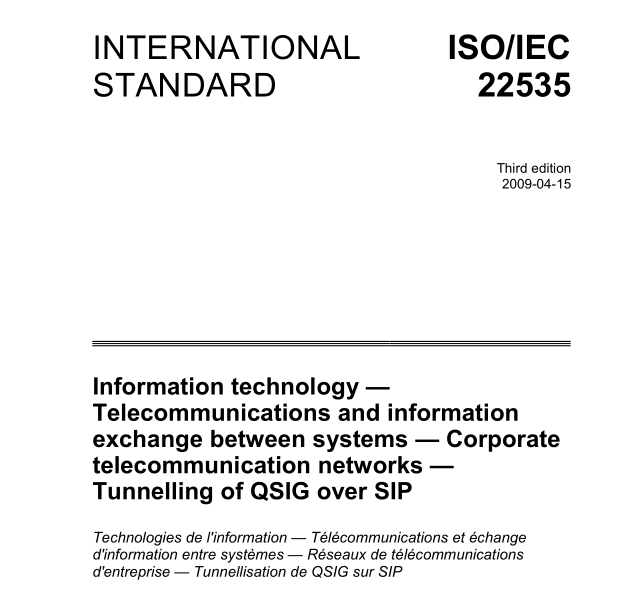ISO IEC 22535:2009 pdfダウンロード

ISO IEC 22535:2009 pdfダウンロード。Information technology — Telecommunications and information exchange between systems — Corporate telecommunication networks — Tunnelling of QSIG over SIP
1 Scope
This International Standard specifies tunnelling of “QSIG” over the Session Initiation Protocol (SIP) within a corporate telecommunication network (CN).
The tunnelling of QSIG through a public IP network employing SIP is outside the scope of this International Standard. However, the functionality specified in this International Standard is in principle applicable to such a scenario when deployed in conjunction with other relevant functionality (e.g. address translation, security functions, etc.).
This International Standard is applicable to any interworking unit that can act as a gateway between a PISN employing QSIG and a corporate IP network employing SIP, with QSIG tunnelled within SIP requests and responses.
2 Normative references
The following referenced documents are indispensable for the application of this document. For dated references, only the edition cited applies. For undated references, the latest edition of the referenced document (including any amendments) applies.
ISO/IEC 11572:2000, Information technology — Telecommunications and information exchange between
systems — Private Integrated Services Network — Circuit mode bearer services — Inter-exchange signalling procedures and protocol
ISO/IEC 11582:2002, Information technology — Telecommunications and information exchange between
systems — Private Integrated Services Network — Generic functional protocol for the support of supplementary services — Inter-exchange signalling procedures and protocol
RFC 2119, Key words for use in RFCs to Indicate Requirement Levels, BCP 14, S. Bradner, March 1997
RFC 2976, The SIP INFO Method, S. Donovan, October 2000
RFC 3204, MIME media types for ISUP and QSIG Objects, E. Zimmerer et al., December 2001
RFC 3261, SIP: Session Initiation Protocol, J. Rosenberg et al., June 2002
RFC 3264, An Offer/Answer Model with the Session Description Protocol (SDP), J. Rosenberg,H. Schulzrinne, June 2002
RFC 3840, Indicating User Agent Capabilities in the Session Initiation Protocol (SIP), J. Rosenberg,H. Schulzrinne, P. Kyzivat, August 2004
3 Terms and definitions
in this document, the key words “MUST””MUST NOT”REQURED””SHALL”SHALL NOT””SHOULD””SHOULD NOT””RECOMMENDED””MAY”nd “OPTIONAL” are to be interpreted as described inRFC 2119 and indicate requirement levels for compliant SIP implementations.
For the purposes of this document, the terms and definitions given in ISOIEC 11572, RFC 3261 and thefollowing apply.
3.1
corporate telecommunication network
CN
sets of privately-owned or carrier-provided equipment that are located at geographically dispersed locationsand are interconnected to provide telecommunication services to a defined group of users
NOTEA CN can comprise a PISN, a private IP network (intranet) or a combination of the two.
3.2
egress gateway
gateway handling a QSIG call or call-independent signalling connection established in the direction IP network
to PISN
3.3
gateway
entity that behaves as a QSIG Transit PINX with QSIG carried over a circuit-switched link within a PISN onone side and QSIG tunnelled over SIP within an IP network on the other side
3.4
ingress gateway
gateway handling a QSIG call or cal-independent signalling connection established in the direction PISN to lP
network
3.5
Pnetwork
network, unless otherwise stated a corporate network, offering connectionless packet-mode services basedon the Internet Protocol (lP) as the network layer protocol
3.6
media stream
audio or other user information transmitted in UDP packets, typically containing RTP, in a single directionbetween the gateway and a peer entity participating in a session established using SIP
NOTENormally a SIP session establishes a pair of media streams, one in each direction.
- Previous:ISO IEC 19792:2009 pdfダウンロード
- Next:ISO IEC 24724:2011 pdfダウンロード